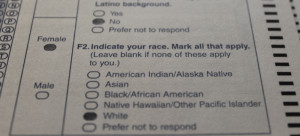Last April, the Supreme Court upheld a Michigan law banning the use of racial criteria in college admissions. This decision was a landmark in an unfolding national political battle over affirmative action, which is defined by the U.S. Commission on Civil Rights as a practice that allows the consideration of race, national origin, sex or disability along with other criteria to provide opportunities to qualified groups of people who have been denied opportunities in the past and to prevent discrimination in the future.
An anonymous white sophomore, who we’ll call James Smith, said he believes his mother was passed over for a job in favor of a less-qualified African-American woman, and that he may face similar obstacles when applying for college or jobs.

“It’s unfair, because if you’re a minority, then you have a better chance of obtaining something for having less of an education,” Smith said. “I know that that’s the reason my mom didn’t get the job, and that actually really upsets me because if I, being a white boy… have a great education and affirmative action comes along, I have a disadvan- tage that plays something I can’t control.”
Affirmative action may have unintended impacts on people of color, particularly high-achieving students. One such student is senior John Atwater, a finalist for the prestigious Morehead-Cain scholarship.
“When I was nominated for the Morehead, I got a lot of, ‘Oh, you were nominated because you’re black,’” Atwater said. “When I got accepted into Carolina, ‘Oh, they accepted you because you’re black.’ When I was just thinking about going to Carolina last year, they were like, ‘Oh, you’ll get in because you’re black.’ My Caucasian friends are like, ‘Yeah, you’ll get in because you’re black, we actually have to work.’ All the awards, all the notoriety that I’ve gotten because of my academics, my scholarship—it just feels like people are saying, ‘You’re only this far because you’re an African American male and that’s it.’ They’re trying to say that if I was Caucasian, then I wouldn’t be in the situation I am today.”
The term “affirmative action” was originally introduced by President John F. Kennedy in 1961 and is intended as a means to “level out the playing field” for minorities. In the 1970s the policy faced backlash, and there was a Supreme Court Case claiming “reverse discrimination” against white people that lead to the outlawing of racial “quotas” by employers or colleges. Other Supreme Court cases since then have upheld affirmative action in its current incarnation.
Affirmative action has increased the number of minority students applying to college, and those who are able to graduate from college earn a much higher salary than high school graduates.
Some students object to affirmative action on the grounds that it is unfair to white applicants for jobs and colleges. Perspectives on affirmative action depend largely on individual interpretations of the equal protection clause in the 14th Amendment.
Shannon Wolfgang, a Northwood faculty member, former admissions counselor for the University of Michigan and application reader for Duke University, said that affirmative action helps a school or employer meet its goals.
“There are many different factors that go into making a decision, and race is indeed one of them at certain universities,” Wolfgang said. “[Those universities] believe that the best kind of learning environment is that of a diverse one, and that means including people of all races, religions, etc. So it’s not necessarily designed to exclude people or include people who aren’t qualified to be at that school; it’s used as a tool to create an environment that that school philosophically thinks is the best environment for their students in which they can learn.”
Senior Jawuanna McAllister said that affirmative action is put in place by colleges to make them look better, and not necessarily to benefit students of color like herself.
“[Schools use affirmative action policies] to give their school a better reputation, plain and simple,” McAllister said. “You know there are colleges out there that say, ‘We want to broaden our perspectives’ and genuinely want to include people of all races. But I think it really comes down to the reputation aspect.”
Beyond improving the status of minority groups, affirmative action may have positive impacts on institutions themselves.
“More diversity creates sparks, discussions, creates relationships,” Atwater said. “You get to meet a whole bunch of new people, and I just feel like there’s more opportunities when there’s more diversity.”
McAllister said that despite the advantage of affirmative action, minorities are still at a disadvantage in the United States.
“Even if African Americans and minorities in general are given advantages when it comes to college and their education, in the long run we are still going to be disadvantaged,” McAllister said. “So, for me and my parents, even though maybe they did benefit from affirmative action, they still have trouble getting jobs.”
Some experts argue that in the modern age, affirmative action should be “race-blind” and focus more on socio- economic inequality. McAllister said that socioeconomic-based affirmative action would lead to the same consequences as race-based affirmative action.
“A lot of your poor and lower class citizens are minorities,” McAllister said. “That kind of eliminates the discrimination factor, but you’ll still have people coming at you in a way, people will still … say, ‘Oh but you have a better chance of getting in because you’re poor,’ instead of saying, ‘Oh, it’s because you’re black.”
The complexities of affirmative action make it difficult for individuals to fully support or reject it.
“People feel like college shouldn’t be based on race, it should be based on academic performance, extracurriculars, SAT scores, ACT scores,” Atwater said. “On the other side, I feel like minorities are still at a disadvantage in today’s society. You look at the statistics: more minorities are in lower socioeconomic classes, generations before us still have the side effects of the Depression and oppression in the 1960s and 1950s from the Civil Rights Movement, and so I see both sides, and if you go toward one side, the other side’s just gonna raise Cain… it’s hard to balance.”
– By Frances Beroset

